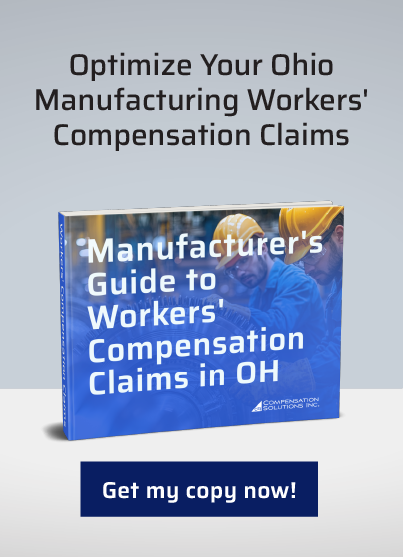Manufacturers: What to Know About Ohio Bureau of Workers' Compensation

Ohio has the third-largest manufacturing sector in the United States. However, with many manufacturing companies comes repeated work-related cases of injuries and illnesses. To combat this effectively, the government established the Ohio Bureau of Workers' Compensation (BWC). It provides medical and compensation benefits to employees who suffer work-related injuries or illnesses.
Understanding and properly navigating the BWC is non-negotiable for manufacturing companies looking to stay compliant and avoid losses. Unfortunately, many employers struggle with this. Their HR personnel are often laden with numerous cases and sometimes lose money from avoidable mistakes.
If you find this relatable, read on, as this post breaks down everything that you need to know about the Ohio BWC.
How Does the Ohio Bureau of Workers' Compensation Calculate Your Premium?
At the heart of the BWC process are premiums. Knowing how the BWC calculates them can help you stay compliant. It can also help you recognize opportunities to save money.
Your BWC premiums are calculated by multiplying your payroll by your classification rate and experience modifier rate (EMR), and dividing it by $100.
Here's a more detailed breakdown.
- Payroll: This is the wages that you pay your employees. It includes most forms of employee compensation, like wages, overtime, commissions, and reported tips. The BWC uses your payroll multiplied by your classification as a primary determinant of your business's exposure to workplace injury. The reasoning is thus: a higher payroll often indicates more hours worked, which shows a greater possibility of workplace injuries occurring.
- Classification Rate: The BWC has hundreds of classification codes depending on the risk associated with the job description. Each has a rate attached to it. Usually, the more risks that a job has, the higher its classification rate is. For example, a metal fabricating company will have a higher classification rate than an electronics company.
- EMR: This measures your claims history compared to the average claims history of your industry classification. An EMR of less than one means your average claim history is better than the industry average; more than one means you have a less-than-average claims history. Companies without a claim history at all (e.g., new companies) usually have an EMR of one.
Save Money by Taking Advantage of Discount Programs
A safe workplace is one of the best ways to save money on BWC premiums. However, manufacturers can also utilize discount programs to save on premium costs.
Group Experience Rating (GER)
You can work with other employers in your sector to get rated collectively through the Group Experience Rating program. With a strong combined claim history, you can receive a premium reduction of up to 53%. To take advantage of this, you must meet specific eligibility requirements regarding claim history and enrollment deadlines.
Group Retrospective Rating (GRR)
The Group Retrospective Rating program is similar to the GER in that the BWC assesses your claims rating as a group. The major difference is that instead of getting a discount up front, you receive a refund later based on the group's claims costs. It’s disbursed over a period of three years.
Safety Councils
The BWC offers discounts to companies that participate in any of its safety councils. Participation includes attending meetings and sharing best practices. You can get up to a 2% discount for attending up to ten meetings yearly.
Drug-Free Safety Programs
The Drug-Free Safety program offers employers who implement drug-free workplace policies and testing procedures up to a 7% discount off premiums. This often includes implementing a written policy, organizing employee training, and performing drug testing before and after employment.
Transitional Work Grant Program
Employers may be eligible for a BWC grant if they create a formal program to allow injured workers to return to work sooner. It can also help you reduce claim costs and retain your skilled workers.
Many of these discounts are stackable, i.e., you can combine them to save more money. CSI offers employers several rebate programs and discount opportunities. Contact us for more information.
Common Mistakes to Avoid When Working with the Ohio Bureau of Workers’ Compensation
Simple mistakes in the claims process can lead to an increase in premiums and claims costs. Common errors to avoid include
- Reporting injuries late: Injuries that are not reported right away may cause problems and make the claims procedure more difficult. Ensure that you report every incident, no matter how small.
- Classifying your employees incorrectly: This affects your premium rates and can lead to back payments, audits, increased costs, and missed discount opportunities.
- Not having written safety policies: A lack of written policies makes it harder to defend against claims.
- Underutilizing your TPA: A TPA can help you manage your entire claims process, ensure you're BWC compliant, and save on discount opportunities. Unfortunately, many employers don't take advantage of the entirety of their services.
How Third-Party Administrators Can Help You Navigate the BWC Process
Third-party administrators (TPAs) like CSI can help you manage claims, navigate BWC regulations, grant you access to discount programs, and represent you during audits and investigations.
Navigating Complex BWC Regulations
For manufacturing employers, meeting BWC's rules and deadlines can be challenging. Unfortunately, missing these rules can have dire consequences and increase premiums and costs.
TPAs are professional claims management personnel who can help you handle every aspect of BWC compliance. For example, CSI’s team members have specialized knowledge and expert understanding of the Ohio BWC's policies. Their experience and expertise will help ensure that you stay compliant and avoid costly mistakes.
Claim Management and Cost Control
TPAs can help you manage your entire claims process, including investigating claims, ensuring timely medical treatment, creating return-to-work programs, and filing for subrogation. Their efforts can help you reduce the cost of claims in the long term and prevent unnecessary premium increases.
Access to Discount Programs
One of the most significant ways that TPAs help manufacturing companies is by granting them access to discount programs. These help employers receive substantial premium discounts by combining their claims history.
Support During Audit and Investigations
In the case of an audit, TPAs provide the necessary support. They ensure that all documents are in order, represent the employer in discussions, and do their best to minimize financial impact and penalties.
Efficient Communication Between Parties
A TPA like CSI serves as a middleperson between the employer, the BWC, the injured party, and medical personnel. This often results in a more efficient and transparent information dissemination process and faster resolution, since they're the single point of contact for all parties.
Let CSI Handle Your Claims Process
TPAs can help you manage your claims process. They ensure that you're compliant while helping you save money on premiums and compensation.
CSI has proven experience handling claim processes for manufacturing businesses in Ohio. Its claims management personnel have years of experience helping employers manage multiple claims processes and the nuances of navigating the Ohio BWC.
Managing workers' compensation claims in Ohio shouldn’t be a headache. Partner with CSI to take the hassle out of claims, lower costs, and stay compliant with Ohio BWC regulations. Focus on your business and employees, and let our seasoned experts guide you through the complexities of workers' comp. Contact us today to streamline the process and experience stress-free claims management!

